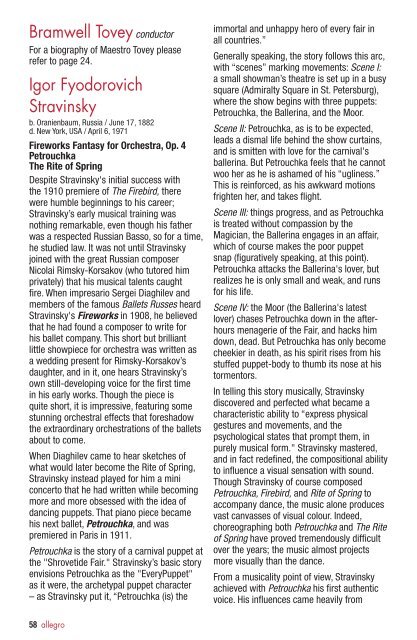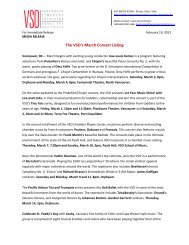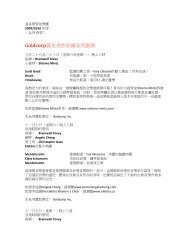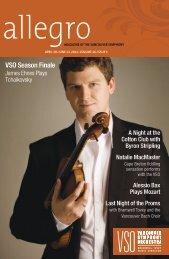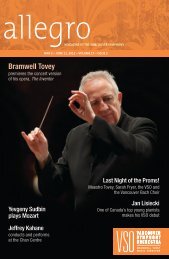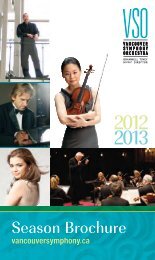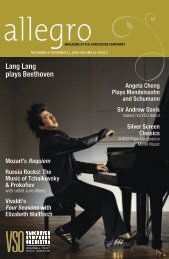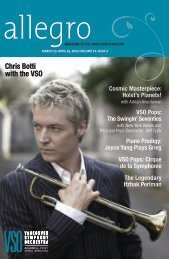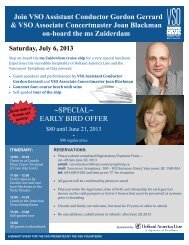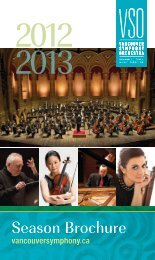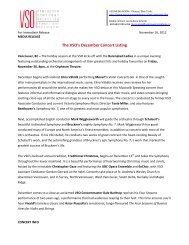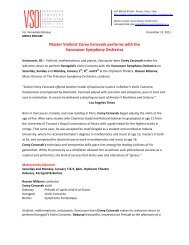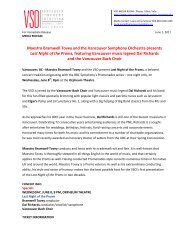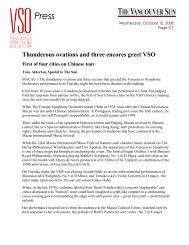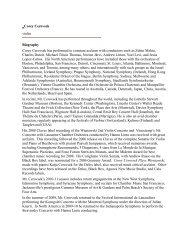issue five - Vancouver Symphony Orchestra
issue five - Vancouver Symphony Orchestra
issue five - Vancouver Symphony Orchestra
You also want an ePaper? Increase the reach of your titles
YUMPU automatically turns print PDFs into web optimized ePapers that Google loves.
Bramwell Tovey conductor<br />
For a biography of Maestro Tovey please<br />
refer to page 24.<br />
Igor Fyodorovich<br />
Stravinsky<br />
b. Oranienbaum, Russia / June 17, 1882<br />
d. New York, USA / April 6, 1971<br />
Fireworks Fantasy for <strong>Orchestra</strong>, Op. 4<br />
Petrouchka<br />
The Rite of Spring<br />
Despite Stravinsky's initial success with<br />
the 1910 premiere of The Firebird, there<br />
were humble beginnings to his career;<br />
Stravinsky’s early musical training was<br />
nothing remarkable, even though his father<br />
was a respected Russian Basso, so for a time,<br />
he studied law. It was not until Stravinsky<br />
joined with the great Russian composer<br />
Nicolai Rimsky-Korsakov (who tutored him<br />
privately) that his musical talents caught<br />
fire. When impresario Sergei Diaghilev and<br />
members of the famous Ballets Russes heard<br />
Stravinsky's Fireworks in 1908, he believed<br />
that he had found a composer to write for<br />
his ballet company. This short but brilliant<br />
little showpiece for orchestra was written as<br />
a wedding present for Rimsky-Korsakov’s<br />
daughter, and in it, one hears Stravinsky’s<br />
own still-developing voice for the first time<br />
in his early works. Though the piece is<br />
quite short, it is impressive, featuring some<br />
stunning orchestral effects that foreshadow<br />
the extraordinary orchestrations of the ballets<br />
about to come.<br />
When Diaghilev came to hear sketches of<br />
what would later become the Rite of Spring,<br />
Stravinsky instead played for him a mini<br />
concerto that he had written while becoming<br />
more and more obsessed with the idea of<br />
dancing puppets. That piano piece became<br />
his next ballet, Petrouchka, and was<br />
premiered in Paris in 1911.<br />
Petrouchka is the story of a carnival puppet at<br />
the "Shrovetide Fair." Stravinsky’s basic story<br />
envisions Petrouchka as the "EveryPuppet"<br />
as it were, the archetypal puppet character<br />
– as Stravinsky put it, “Petrouchka (is) the<br />
immortal and unhappy hero of every fair in<br />
all countries.”<br />
Generally speaking, the story follows this arc,<br />
with “scenes” marking movements: Scene I:<br />
a small showman’s theatre is set up in a busy<br />
square (Admiralty Square in St. Petersburg),<br />
where the show begins with three puppets:<br />
Petrouchka, the Ballerina, and the Moor.<br />
Scene II: Petrouchka, as is to be expected,<br />
leads a dismal life behind the show curtains,<br />
and is smitten with love for the carnival's<br />
ballerina. But Petrouchka feels that he cannot<br />
woo her as he is ashamed of his “ugliness.”<br />
This is reinforced, as his awkward motions<br />
frighten her, and takes flight.<br />
Scene III: things progress, and as Petrouchka<br />
is treated without compassion by the<br />
Magician, the Ballerina engages in an affair,<br />
which of course makes the poor puppet<br />
snap (figuratively speaking, at this point).<br />
Petrouchka attacks the Ballerina's lover, but<br />
realizes he is only small and weak, and runs<br />
for his life.<br />
Scene IV: the Moor (the Ballerina's latest<br />
lover) chases Petrouchka down in the afterhours<br />
menagerie of the Fair, and hacks him<br />
down, dead. But Petrouchka has only become<br />
cheekier in death, as his spirit rises from his<br />
stuffed puppet-body to thumb its nose at his<br />
tormentors.<br />
In telling this story musically, Stravinsky<br />
discovered and perfected what became a<br />
characteristic ability to “express physical<br />
gestures and movements, and the<br />
psychological states that prompt them, in<br />
purely musical form." Stravinsky mastered,<br />
and in fact redefined, the compositional ability<br />
to influence a visual sensation with sound.<br />
Though Stravinsky of course composed<br />
Petrouchka, Firebird, and Rite of Spring to<br />
accompany dance, the music alone produces<br />
vast canvasses of visual colour. Indeed,<br />
choreographing both Petrouchka and The Rite<br />
of Spring have proved tremendously difficult<br />
over the years; the music almost projects<br />
more visually than the dance.<br />
From a musicality point of view, Stravinsky<br />
achieved with Petrouchka his first authentic<br />
voice. His influences came heavily from<br />
58 allegro


